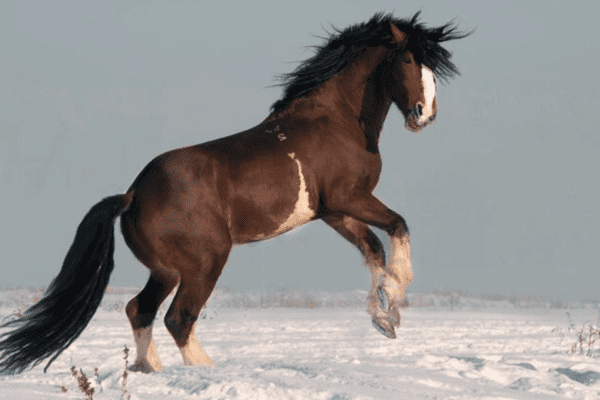The Vladimir Heavy Draft, originating from Russia, represents a notable breed in the realm of heavy draft horses. Its development traces back to the early 20th century, primarily in the agricultural settings of Ivanovo and Vladimir Oblasts, regions lying to the east of Moscow.
The breed’s evolution was significantly influenced by the genetic contribution of three Clydesdale stallions, born during the period from 1910 to 1923. This deliberate and strategic breeding led to the official recognition of the Vladimir Heavy Draft in 1946, establishing it as a cornerstone in Russia’s equestrian heritage.
History
The Vladimir Heavy Draft horse, one of Russia’s esteemed breeds, emerged through a process of strategic breeding and adaptation over time. Beginning during an era when Russia did not possess its own indigenous heavy draught horse breeds despite having vast agricultural demands on it, along with simultaneous development of Ukrainian Heavy Draught horses as potential solutions to fill this void.
Early Development (1886-1924).
Between 1886 and 1924, the breeding foundation for the Vladimir breed was laid. Gavrilov Posad, in Ivanovo Oblast, became its epicenter, with deliberate crossbreeding experiments taking place between local horses known for hardiness but lacking size and strength to complete heavy draft work and imported Clydesdale stock selected specifically for this purpose. Crossbreeding wasn’t random; rather it was done to promote specific traits.
Diversification of Genetic Influences
Additionally, Clydesdale genes were selectively mixed in with those from other notable breeds such as Cleveland Bays, Percherons and Suffolk Punchs to form Vladimir breed. Each contributed unique strengths and characteristics that further enhanced draft capabilities of Vladimir breed. Between 1919-1929 there was also significant involvement from Shire mares which further diversified genetic makeup while broadening draft capabilities.
Foundation Stallions
Clydesdale breed development was propelled forward with the arrival of three foundation stallions: Border Brand and Lord James were both born in 1910 while Glen Albin arrived later that same year. Together, these three stalions are widely known as foundation stallions as their standards and characteristics formed the basis of Clydesdale breeding standards and characteristics today.
Refinement and Recognition
Crossbreeding began to diminish during the 1920s. For two decades following this period of refinement and stabilization of breed characteristics and type were carefully monitored in order to establish and distinguish Vladimir Heavy Draft from its ancestors and contemporaries.
After years of meticulous breeding and refining, the Vladimir Heavy Draft finally received formal recognition in 1946 – not as just another formality, but rather as a testament to its distinct qualities and successful attainment of breeding objectives.

Physical Characteristics
These dogs typically boast a solid build with broad chest, strong legs and well-muscled body. Size: They typically reach 15-16 hands tall but possess remarkable strength for their size.
Coat Colors: Bay, roan and chestnut are three popular coat colors for dogs.
Temperament and Behavior
Tendency: Recognized for their gentle demeanor, Arabian horses can easily be trained for various tasks beyond heavy labor. Their calm disposition makes them ideal companions.
Adaptability: Their hardy nature allows them to thrive even in harsh climates, something passed down from their Russian ancestry.
Uses and Contributions
Draft Animals have traditionally been utilized in agricultural work such as plowing and other heavy farm tasks, while their current role has evolved with decreased demand in agriculture; now used for recreation including riding and harness work.
Conservation Status: Although not endangered, the Vladimir Heavy Draft is considered rare breed and steps are in place to maintain its heritage and characteristics.

Cultural Significance
This breed is an iconic emblem of Russia’s agricultural history and rural life. Festivals and Shows: These animals can often be seen at regional horse shows and cultural events that honor them for their historical and agricultural significance.

